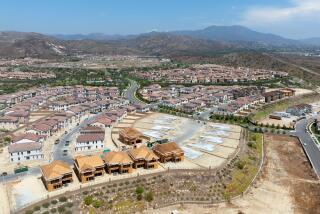Preserving Small Part of Countyâs Ranch Past
The cornerstone of the giant Irvine Ranch will become a museum under a donation to the local historical society.
The ranchâs founder, James Irvine I, built the first wooden house in the area on the 3/4-acre lot in 1868. All that remains on the land, donated to the Irvine Historical Society, is an addition built nine years later for the workers who tended the cattle and sheep.
Joan Irvine Smith, great-granddaughter of James Irvine, said that through her Joan Irvine Smith and Athalie R. Clarke Foundation, she probably would pay to rebuild the original two-story house, which was torn down in 1961.
âTo be able to reconstruct the house and to be able to restore it is doing something my mother really wanted,â said Smith, who is not affiliated with the Irvine Co. âDuring her lifetime, she was so disappointed when the management of the company wouldnât allow us to lease it. It really means a lot to the family.â
If the two-story house is built, Smith would like to fill it with period pieces like those her grandfather might have owned. Gail Daniels, president of the historical society, said there were no definite plans for the house, but it could be turned into a museum. She said the historical society has asked the city for $25,000 to help restore the dining area.
A private ceremony to mark the donation will be held at the site today.
The addition is the oldest standing structure on the ranch, said Judy Gauntt, author of âIrvine, A History of Growth and Innovation.â It has housed the Irvine Historical Museum, which the society has run since 1980 and chronicles the history of the Irvine Ranch. The ranch once encompassed 125,000 acres, about one-fifth of present-day Orange County.
The original building was the first wooden house between Anaheim and San Diego, although in those days there wasnât a whole lot there.
The land backs up to Rancho San Joaquin Golf Course, which at one time used the dining area as a sports shop and snack bar.
Smith recalled the house was typical of the period: smallish--Gauntt figures 20 feet by 20 feet. It had four bedrooms upstairs, a dining room and a living room. The house was painted white and a porch ran all the way around. It had a white picket fence and a huge pepper tree.
James Irvine lived in San Francisco most of the time and after taking the stagecoach to check on his southern properties, he would stay at the house. Irvine and two partners he later bought out paid 37 cents an acre for the 48,303 acres of Rancho San Joaquin to Jose Andres Sepulveda in 1864. The acreage eventually made up the southern end of the Irvine Ranch.
In 1870, the new ranch superintendent, Charles E. French, moved into the house, but Irvine continued to stay there when he visited. The French Park section of Santa Ana was named after French.
According to Gaunttâs book, French called the rancho âGod-forsaken land with coyotes barking, wild cats screaming, and not a light to be seen anywhere in the darkness of night.â
The worst problem, though, were the fleas. âAt night after undress, a person jumped into bed as quickly as possible in order not [to] get them in the bed,â he wrote, according to Gauntt.
The house also was the spot where Newport Beach was named. After a 105-ton river steamer came into the bay, Irvine and friends decided that this was a new port, and the name stuck, Gauntt said.
The house fell into disrepair about 1940 when people stopped living there. âThey tore down the big building because they considered it an eyesore,â Gauntt said.
The historical society had been leasing what was left of the house for about $1,900 a year. The lease was going to expire in March, and Daniels said she wrote the Irvine Co. asking it to donate the property.
âWouldnât you know? They agreed,â she said.
More to Read
Sign up for Essential California
The most important California stories and recommendations in your inbox every morning.
You may occasionally receive promotional content from the Los Angeles Times.











